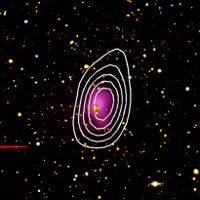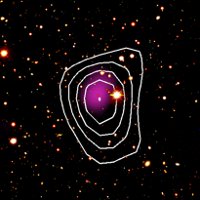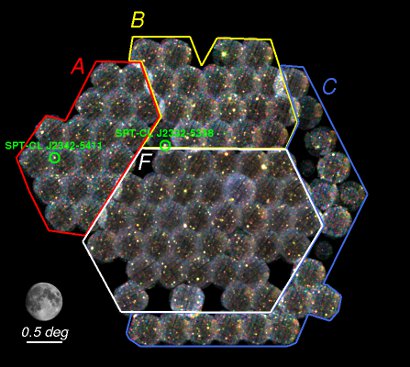Novel observing mode on XMM-Newton opens new perspectives on galaxy clusters
31 May 2010
Surveying the sky, XMM-Newton has discovered two massive galaxy clusters, confirming a previous detection obtained through observations of the Sunyaev-Zel'dovich effect, the 'shadow' they cast on the Cosmic Microwave Background. The discovery, made possible thanks to a novel mosaic observing mode recently introduced on ESA's X-ray observatory, opens a new window to study the Universe's largest bound structures in a multi-wavelength approach.Galaxy clusters are the largest gravitationally bound objects in the Universe. As such, they are extremely important probes of cosmic properties on very large scales, since they form in the densest knots of the large-scale structure, the cosmic web. Originally discovered as an excess density (or cluster) of galaxies located at the same redshift, hence the name, there is much more to these enormous structures than mere galaxies: in fact, only about one tenth of the entire mass of a galaxy cluster arises from galaxies (up to a thousand in the most massive cases), another tenth consists of hot gas, and the remainder can be attributed to dark matter.
The gas that fills galaxy clusters is hot enough to emit X-rays — with a temperature of more than 10 million Kelvin, the gas is ionised and electrons scattering off ions are decelerated, emitting radiation in the process. From measurements of the X-ray luminosity of galaxy clusters and of the gas temperature, the total mass of these structures can be estimated. This yields clear evidence that clusters are indeed gravitationally bound structures and that their mass is dominated by the elusive and invisible dark matter.
 |
 |
|
The two massive galaxy clusters discovered with XMM-Newton. Left: SPT-CL J2332-5358; Right: SPT-CL J2342-5411. (Click on images for extended captions and credit details.) | |
"Interestingly, the same hot gas we directly observe in X-rays also affects the photons of the Cosmic Microwave Background (CMB), which are passing through the cluster on their way to us," says Hans Böhringer from the Max-Planck Institute for Extraterrestrial Physics. The CMB photons interact with the extremely energetic electrons in the cluster plasma and in doing so their energy is modified in a very characteristic way, leaving a signature on the CMB — the so-called Sunyaev-Zel'dovich Effect (SZE). "We can then see clusters as 'shadows' cast on the CMB in the millimetre subset of radio wavelengths," Böhringer adds.
A survey of the sky at millimetre wavelengths, currently being carried out with the South Pole Telescope (SPT), has recently achieved its first results, detecting a dozen of previously unknown galaxy clusters by means of their SZE signature. Follow-up observations in the optical and X-rays are, however, needed in order to better characterise the physical properties of these structures and to probe how the observed SZE signal depends on the mass of the clusters.
"Using XMM-Newton, we have independently detected two of the newly discovered clusters found by the SPT," says Róbert Suhada, who led the study. Using the X-ray data, the mass of both clusters could be estimated, leading to values of over 1015 solar masses and about 3x1014 solar masses, respectively. "One of the clusters is exceptionally massive, and it ranks among the hottest clusters ever observed," adds Suhada.
The discovery was possible thanks to a new mode of observations recently implemented by the XMM-Newton Science Operations Centre. "The new mosaic observing mode enables us to survey large areas of the sky in a much more efficient way than previously," explains Maria Santos-Lleo, XMM-Newton Science Support Manager.
ESA's X-ray observatory has been operating for more than ten years, but the demand for observing time is still high and is often driven by new science goals — some of them unexpected during the project phase, over a decade ago. In some cases, the scientific objectives require the observation of sky regions larger than the field of view of the cameras aboard the spacecraft. This pushes the support scientists to implement new operating modes that optimise the performance of the instruments. "It is difficult, and very rare, to develop new modes when the spacecraft is already in orbit and operating. In this particular case, we succeeded in figuring out a novel way to exploit the instruments in order to satisfy new needs of the astronomical community," adds Santos-Lleo. Thanks to the mosaic mode, it was possible to extend the observed patch of the sky to about 14 square degrees, about 70 times the area of the full Moon.
 |
|
Mosaic mode XMM-Newton image of the entire XMM-BCS survey field. (Click on image for extended caption and credit details.) |
Besides the SZE detection and X-ray data, optical observations of the galaxies in the two clusters enabled their redshifts to be established: z=0.3 (in the case of the more massive one) and z=1.0, respectively. This is the very first joint discovery of galaxy clusters in a sky survey combining data probing these three different wavebands.
"This survey not only shows that we can efficiently detect galaxy clusters in all these wavelengths, but also that the cluster redshifts reach easily as far as z=1, a necessary condition to follow structure evolution over an interesting cosmological time span," Hans Böhringer comments. The most distant of the two clusters is in fact seen as it was when the Universe was barely 6000 million years old, less than a half of its current age.
This result opens a new window to probe galaxy clusters to very high redshifts, which will be exploited by future missions examining different regions of the electromagnetic spectrum. One of the scientific goals of ESA's Planck mission, which is currently scanning the whole sky in microwaves, is to detect about 1000 galaxy clusters through their SZE signal imprinted on the CMB. The Euclid mission, a candidate Cosmic Vision M-class mission, is expected to detect a large number of clusters in optical and near-infrared wavelengths, thanks to its wide field of view, and to identify their redshifts. This first discovery is thus a preview of future galaxy cluster surveys and of the exciting scientific results they will bring, in the process expanding our knowledge about the evolution of cosmic structure.
Notes for editors
The two galaxy clusters detected in this study are SPT-CL J2332-5358 and SPT-CL J2342-5411, with photometric redshifts of z=0.32 and z=1.08, respectively. The photometric redshifts were obtained from optical data from the Blanco Cosmology Survey. The cluster temperatures are about T=9.3 keV (= 108 million Kelvin) and T= 4.5 keV (= 52 million Kelvin), respectively. With a mass of over 1015 solar masses, SPT-CL J2332-5358 is among the hottest and most massive clusters known; SPT-CL J2342-5411 is less massive (about 3x1014 solar masses) but is among the most distant known clusters to have been detected both through X-ray emission and SZE.
The new mosaic observing mode allows large areas of the sky, larger than the field of view of the cameras aboard the spacecraft, to be surveyed in a very efficient way. This is achieved by means of a single calibration measurement, which is performed at the beginning of the observing series and takes only up to one hour, and is then applied to all adjacent fields that are subsequently observed. This is clearly much cheaper, in terms of observing time, than the previous mode, in which the calibration measurements were performed for each field individually, consuming up to one hour for each estimate.
This new mode can be applied to observations of several astrophysical environments (for example galaxy clusters, supernova remnants, crowded fields) which require large areas of the sky to be surveyed with exposure times from a few minutes to a couple of hours.
The XMM-Newton spacecraft is controlled by the European Space Operations Centre (ESOC, Darmstadt, Germany) using ground stations at Perth (Australia) and Kourou (French Guiana). The XMM-Newton Science Operations Centre situated at ESAC in Villafranca, Spain, manages observation requests and receives XMM-Newton data. The XMM-Newton Survey Science Centre (SSC), at Leicester University, UK, processes and correlates all XMM-Newton observations with existing sky data held elsewhere in the world.
Related publications
Suhada, R., et al., "XMM-Newton detection of two clusters of galaxies with strong SPT Sunyaev-Zel'dovich effect signatures", Astronomy & Astrophysics, Vol. 514, L3, 2010. DOI: 10.1051/0004-6361/201014434
The paper appeared in May 2010 issue of Astronomy & Astrophysics.
Contacts
Róbert Suhada
Max-Planck Institute for Extraterrestrial Physics, Germany
Phone: +49-(0)89-30000-3892
Email: rsuhada mpe.mpg.de
mpe.mpg.de
Hans Böhringer
Max-Planck Institute for Extraterrestrial Physics, Germany
Phone: +49-(0)89-30000-3347
Email: hxb mpe.mpg.de
mpe.mpg.de
Maria Santos-Lleo, XMM-Newton Science Support Manager
XMM-Newton Science Operations Centre
Directorate of Science and Robotic Exploration
European Space Agency
Phone: +34-(0)91-8131-276
Email: Maria.Santos-Lleo sciops.esa.int
sciops.esa.int
Norbert Schartel, ESA XMM-Newton Project Scientist
Directorate of Science and Robotic Exploration European Space Agency
Phone: +34-(0)91-8131-184
Email: Norbert.Schartel esa.int
esa.int

